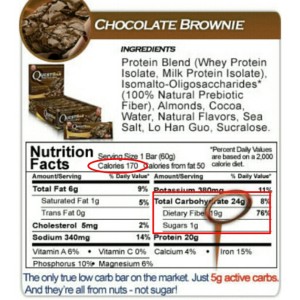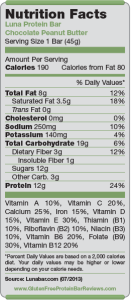Notice the two areas I outlined in red.
1. I circled 170 calories. Why? Well based off the macro-nutrient numbers it seems this bar is not 170 calories. It’s actually 230 calories.
How? Check it out:
24g of Carbohydrates X 4 =96 calories
20g of Protein X 4 =80 calories
6g of Fat X 9 = 54 calories
96 + 80 + 54 = 230 calories
You can see how 170 calories must be incorrect.
BUT WAIT…..!
2. Notice the red box? That area is usually where people go wrong.
The label says “the only true low carb bar….just 5g active carbs”
How can this be a low carb bar with 5g of carbohydrates when it clearly states 24g of TOTAL CARBOHYDRATES on the nutrition label?
LET ME EXPLAIN:
3 contents are located within that red box:
1. Total Carbohydrates
2. Dietary Fibers
3. Sugars
***This information may be difficult to comprehend if you aren’t aware of the type of carbohydrates
The main content out of the 3 would be “Total Carbohydrates“.
Why?
Because the word “Total” includes the Fiber and Sugar contents.
For example: Look at the photo above and notice the 3 contents.
The label states:
Total Carbohydrates: 24g
Dietary Fibers: 19g
Sugars: 1g
So the total 24g of carbs actually have 19g of fiber and 1g of sugar in it. Fiber is not an active carb so we subtract its contents (19g) from the 24g which leaves 5g of carbs.
So does Quest Bar actually have 5g of carbs? Yes.
The fiber content is just really high, which makes it seem that the carbohydrates are high. Even if that fiber content was fabricated (higher or lower) the calorie content wouldn’t change. So this bar is actually 170 calories and not 230. It would be 230 calories only if it actually had 24g of carbohydrates in it.
Why does any of this matter?
It matters because when you track your macros, you may end up miscalculating. If you have a carbohydrate limit of 100g and look at a Quest Bar; you may think 2 bars would equal half your limit when actually it would only be 10%(10g of carbs). This logic doesn’t only apply for Quest Bars, it applies for anything with a Fiber Content. Knowing this information gives you an advantage when it comes to investigating your calories.
Remember: The carbohydrate content may not be what it says due to the fiber. Fiber is a carbohydrate, but not a kind that the body utilizes for energy for growth. That is why we dismiss the fiber gram content and focus on the remaining number.
The remaining carbohydrate number needs to be figured out. Figure out what? You need to know if the remaining carbohydrates are simple or complex.
How do I know if the remaining are Simple or Complex?
Once you subtract the fiber grams from total carbohydrate grams (if there are any) you look at how many grams of sugar there are. You take the total carbohydrate content and subtract it from the sugar content.
For example: Let’s use the information from the image above:
After you remove the fiber you get 5g of carbs remaining. Inside that 5g is 1g of sugar. The “Sugar” content will always be simple sugars, after subtracting the remaining sugars will always be complex. So you can see the Quest Bar with the nutrition label above has 1g of simple carbohydrates and 4g of complex carbohydrates.
Sometimes foods will list how many carbs are complex under the name of “Other Carbs” For example; Luna Bars; look at the image below.
Total Carbohydrates: 19g
Fiber: 3g
Sugar: 12g
I’ll show you how they get 3g of Other Carbs:
How:
19g Total Carbohydrates – 3g of Fiber = 16g of carbs leftover
Out of the 16 carbs leftover we know 12 of them are simple since anything under the sugar content are automatically simple. So 16g-12g=4g complex carbs. Yes they put 3, but all companies round.
Why does this matter?
Knowing how many complex carbs vs simple carbs will help you decide which foods to eat while trying to achieve your goals.
I find this information rather important because YOU THINK you are hitting your mark when really the math may be wrong due to you being unaware of certain information.
Remember:
– Double check the amount of carbs something may have in it. It may be less than you think.
– Thank you!

